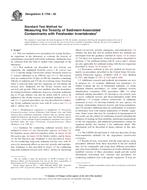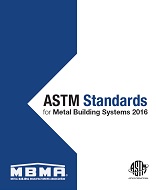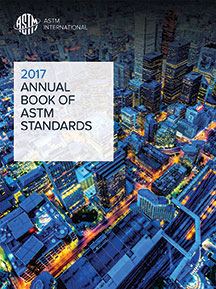
ASTM E1706-05
1.1 This test method covers procedures for testing freshwater organisms in the laboratory to evaluate the toxicity of contaminants associated with whole sediments. Sediments may be collected from the field or spiked with compounds in the laboratory.
1.1.1 Test methods are described for two toxicity test organisms, the amphipod Hyalella azteca ( H. azteca) (see ) and the midge Chironomus dilutus (formerly known as C. tentans; Shobanov et al. 1999.
Note 1
Morphological comparison of populations of Chironomus (Camptochironomus) tentans(Fabricius) from Europe, Asia, and North America have confirmed cytogenetic evidence that two distinct species inhabit the Palearctic and Nearctic under this name. The Palearctic species is the true C. tentans and the Nearctic populations constitute a new species described under the name Chironomus (Camptochironomus) dilutus (Shobanov et al. 1999
1.1.2 Guidance for conducting sediment toxicity tests is outlined in for Chironomus riparius, in for Daphnia magna and Ceriodaphnia dubia, in for Hexagenia spp., in for Tubifex tubifex, and in for the Diporeia spp. Guidance is also provided in for conducting long-term sediment toxicity tests with H. azteca by measuring effects on survival, growth, and reproduction. Guidance is also provided in for conducting long-term sediment toxicity tests with C. dilutus by measuring effects on survival, growth, emergence, and reproduction. outlines the data that will be needed before test methods are developed from the guidance outlined in to for these test organisms. General procedures described in Sections for sediment testing with H. azteca and C. dilutus are also applicable for sediment testing with the test organisms described in to .
1.2 Procedures outlined in this test method are based primarily on procedures described in the United States Environmental Protection Agency (USEPA)
1.3 Additional research and methods development are now in progress to: (1) evaluate additional test organisms, (2) further evaluate the use of formulated sediment, (3) refine sediment dilution procedures, (4) refine sediment toxicity identification evaluation (TIE) procedures
1.4 The USEPA
1.5 Results of tests, even those with the same species, using procedures different from those described in the test method may not be comparable and using these different procedures may alter bioavailability. Comparison of results obtained using modified versions of these procedures might provide useful information concerning new concepts and procedures for conducting sediment tests with aquatic organisms. If tests are conducted with procedures different from those described in this test method, additional tests are required to determine comparability of results. General procedures described in this test method might be useful for conducting tests with other aquatic organisms; however, modifications may be necessary.
1.6 Selection of Toxicity Testing Organisms
1.6.1 The choice of a test organism has a major influence on the relevance, success, and interpretation of a test. Furthermore, no one organism is best suited for all sediments. The following criteria were considered when selecting test organisms to be described in this standard ( and Guide E 1525). A test organism should: (1) have a toxicological data base demonstrating relative sensitivity and discrimination to a range of chemicals of concern in sediment, (2) have a database for interlaboratory comparisons of procedures (for example, round-robin studies), (3) be in contact with sediment [e.g., water column vs benthic organisms], (4) be readily available through culture or from field collection, (5) be easily maintained in the laboratory, (6) be easily identified, (7) be ecologically or economically important, (8) have a broad geographical distribution, be indigenous (either present or historical) to the site being evaluated, or have a niche similar to organisms of concern, (for example, similar feeding guild or behavior to the indigenous organisms), (9) be tolerant of a broad range of sediment physico-chemical characteristics (for example, grain size), and (10) be compatible with selected exposure methods and endpoints. The method should also be (11) peer reviewed and (12) confirmed with responses with natural populations of benthic organisms (see ).
1.6.2 Of the criteria outlined in , a data base demonstrating relative sensitivity to contaminants, contact with sediment, ease of culture in the laboratory, interlaboratory comparisons, tolerance of varying sediment physico-chemical characteristics, and confirmation with responses of natural benthos populations were the primary criteria used for selecting H. azteca and C. dilutus to be described as test methods in the current version of this standard (see Sections and ). Procedures for conducting sediment tests with organisms in accordance with to do not currently meet all the required selection criteria listed in . A similar data base must be developed before these or other test organisms can be included as standard test methods instead of as guidance in future versions of these this method.
1.6.3 An important consideration in the selection of specific species for test method development is the existence of information concerning relative sensitivity of the organisms both to single chemicals and complex mixtures. A number of studies have evaluated the sensitivity of H. azteca, C. dilutus, and L. variegatus, relative to one another, as well as other commonly tested freshwater species. For example, Ankley et al
In a study of contaminated Great Lakes sediment, H. azteca, C. dilutus, and C. ripariuswere among the most sensitive and discriminatory of 24 organisms tested
In 10-day water-only and whole-sediment tests, Hyalella azteca and C. dilutus were more sensitive than D. magna to fluoranthene-spiked sediment
Ten-day, water-only tests also have been conducted with a number of chemicals using H. azteca, C. dilutus, and L. variegatus (
Using the data from , sensitivity of H. azteca, C. dilutus, and L. variegatus can be evaluated relative to other freshwater species. For this analysis, acute and chronic toxicity data from water quality criteria (WQC) documents for copper, zinc, cadmium, nickel, lead, DDT, dieldrin, and chlorpyrifos, and toxicity information from the AQUIRE data base
Measurable concentrations of ammonia are common in the pore water of many sediments and have been found to be a common cause of toxicity in pore water
Although these studies provide benchmark concentrations that may be of concern in sediment pore waters, additional studies by Whiteman et al.
1.6.4 Relative species sensitivity frequently varies among chemicals; consequently, a battery of tests including organisms representing different trophic levels may be needed to assess sediment quality
Sensitivity of a species to chemicals is also dependent on the duration of the exposure and the endpoints evaluated. describe results of studies which demonstrate the utility of measuring sublethal endpoints in sediment toxicity tests with the amphipod H. azteca and the midge C. dilutus.
1.6.5 The sensitivity of an organism to chemicals should be balanced with the concept of discrimination
1.6.6 Sensitivity of an organism is related to route of exposure and biochemical sensitivity to chemicals. Sediment-dwelling organisms can receive a dose from three primary sources: interstitial water, sediment particles, and overlying water. Food type, feeding rate, assimilation efficiency, and clearance rate will control the dose of chemicals from sediment (Guide E 1688). Benthic invertebrates often selectively consume different particle sizes
1.6.7 Despite the potential complexities in estimating the dose that an animal receives from sediment, the toxicity and bioaccumulation of many chemicals in sediment such as chlordecone, fluoranthene, organochlorines, and metals have been correlated with either the concentration of these chemicals in interstitial water or in the case of nonionic organic chemicals, concentrations of an organic-carbon basis
1.6.8 The response of H. azteca and C. dilutus in laboratory toxicity studies has been compared to the response of natural populations of benthic organisms to potentially contaminated sediments.
Chironomids were not found in sediment samples that decreased the growth of C. dilutus by 30 % or more in 10-day laboratory toxicity tests
Canfield et al. (
Results from laboratory sediment toxicity tests were compared to colonization of artificial substrates exposed in situ to Great Lakes sediment
Sediment toxicity with amphipods in 10-day toxicity tests, field contamination, and field abundance of benthic amphipods were examined along a sediment contamination gradient of DDT
1.7 Limitations While some safety considerations are included in this standard, it is beyond the scope of this standard to encompass all safety requirements necessary to conduct sediment tests.
Product Details
- Published:
- 03/01/2005
- Number of Pages:
- 118
- File Size:
- 1 file , 1.6 MB
- Redline File Size:
- 2 files , 2.6 MB

